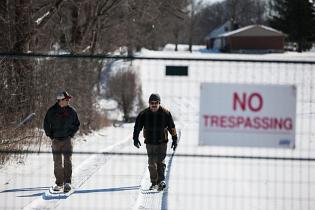A Pipeline, Some Rabbit traps, and a 300-year-old Treaty
Two Haudenosaunee men are facing a court injunction filed by Enbridge Inc. that they say is denying them their traditional hunting rights.
Earlier this month, an Ontario Superior Court judge granted the injunction against Wayne Hill and Todd Williams for setting a series of live rabbit traps and blocking workers’ access at sites along Enbridge’s Line 10 pipeline.
It’s the latest move in an escalating dispute over Enbridge’s maintenance work on the pipeline, which has run through traditional Haudenosaunee territory near Hamilton since it was built in the 1960s.
“I was talking to them, and meeting with their indigenous liaison, and they said ‘well, we don’t have to involve you,’” Williams said.
Enbridge says the current digging at the contested sites along Line 10 is not a new project, but part of standard maintenance the company does on all its pipelines, and it doesn’t require consultation with the Haudenosaunee.
The company says it did notify the elected band councils of the Six Nations of the Grand River and the Mississauga’s of the New Credit before maintenance work began.
Williams – an engineer – and Hill represent the Haudenosaunee Development Institute, an arm of the unelected Haudenosaunee Confederacy Chiefs Council. Together Williams and Hill oversee the institute’s environmental and archeological monitoring program.
They want Enbridge to notify them of planned excavation work along the aging pipeline and to pay the costs for Haudenosaunee monitoring staff on worksites where preventative maintenance is being done, to ensure that the work is carried out according to accepted environmental and archeological standards.

Sections of Line 10 are due to be upgraded and replaced over the coming two years.
That constitutes a new project, called the Line 10 Westover Segment Replacement Project, for which Enbridge is consulting with local indigenous groups.
It’s been paying for Haudenosaunee monitors on the Westover Segment replacement project since November 2015.
When the existing Line 10 was built there were no agreements in place at all.
Hill worries that the maintenance work being done now risks uncovering important archeological sites that may have been missed in the 60s.
Enbridge says should that happen, the company would stop work and notify the provincial government, the landowner and the appropriate First Nation.
But that’s not good enough for Williams and Hill. They want to be included at the outset of maintenance work just like they are for new projects.
“It’s more about observing and sharing information about what’s going on,” Williams said. “Why not have native monitors? That’s what we’ve been trying to establish.”
Williams said what he and Hill are asking for is exactly what they get from other pipeline companies operating in the area, including TransNorthern and Imperial Oil.

“We’re like an independent third party observer making sure the archeologist has rules and that it’s overseen to ensure that nothing is missed,” Williams said.
But Enbridge refuses to work with them, Williams said.
“They’re not involving us. They’re saying they don’t have to,” he said.
“It’s kind of ignorant, really,” Hill said. “We’ve been here long before Enbridge ever arrived. We have treaty rights.”
Frustrated, Williams and Hill began showing up at Enbridge dig sites earlier this winter and refusing the workers access. On one occasion, Williams blocked access to a work site with his pick up truck. Another time the Hamilton Police were called, though neither Williams nor Hill have been arrested or charged.
But with more than 10 active dig sites along the pipeline, it was like whack-a-mole. Every time Williams and Hill left one location for another, Enbridge would simply continue the work once they’d left.
That’s when Williams started placing steel cage live traps at the sites.
He’s been checking the trap line daily for the past few weeks. He hasn’t caught anything yet, but that’s not really the point. The traps are a tactic.

The right to hunt freely across Haudenosaunee land is protected by a 300-year-old treaty.
Signed in 1701 with the British, the Haudenosaunee ceded all the land of present-day southwestern Ontario to the crown in return for a guarantee of free and undisturbed hunting rights in the territory forever.
Williams and Hill argue that treaty is still in effect and at least one Ontario court ruling appears to agree with them.
In 1989 two Oneida men were found hunting raccoons in the same territory, in violation of Ontario’s Game and Fish Act. They were charged with hunting without a license. But at trial, Judge G.A. Phillips dismissed the charges, saying the treaty of 1701 exempted the Oneidas from the provincial law.
In his ruling granting Enbridge’s injunction, however, Justice David. A Broad ruled that even though the 1701 treaty may still apply in certain cases, it does not justify Williams’ and Hill’s “unlawful” resort to setting traps and blocking the work sites.
Enbridge says the men are interfering with the regular operations of the pipeline, and putting workers and the environment at risk.
In the statement of claim, Enbridge also accuses the men of causing $400,000 worth of damages due to trespassing, an additional $400,000 in damages from intimidation and breaching the peace.
“We have reached out, in person and in writing, to understand (the Haudenosaunee’s) concerns but a negotiated resolution has not been achieved and the two individuals continued to interfere with the preventative maintenance work,” Enbridge spokeswoman Suzanne Wilton wrote in an emailed statement.
Hill says he feels his and Williams’ request isn’t unreasonable.
“To have a colonial company like Enbridge say they don’t have to engage or respect those treaty rights, it just makes my blood boil,” he said.
Comments
There are 0 comments on this post





